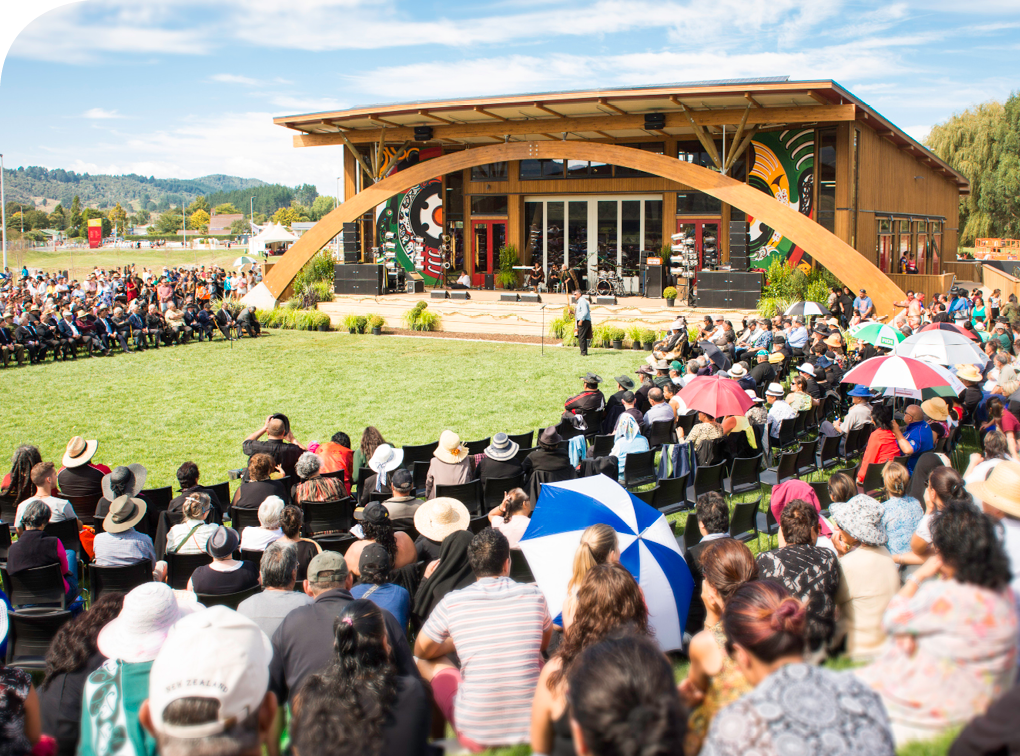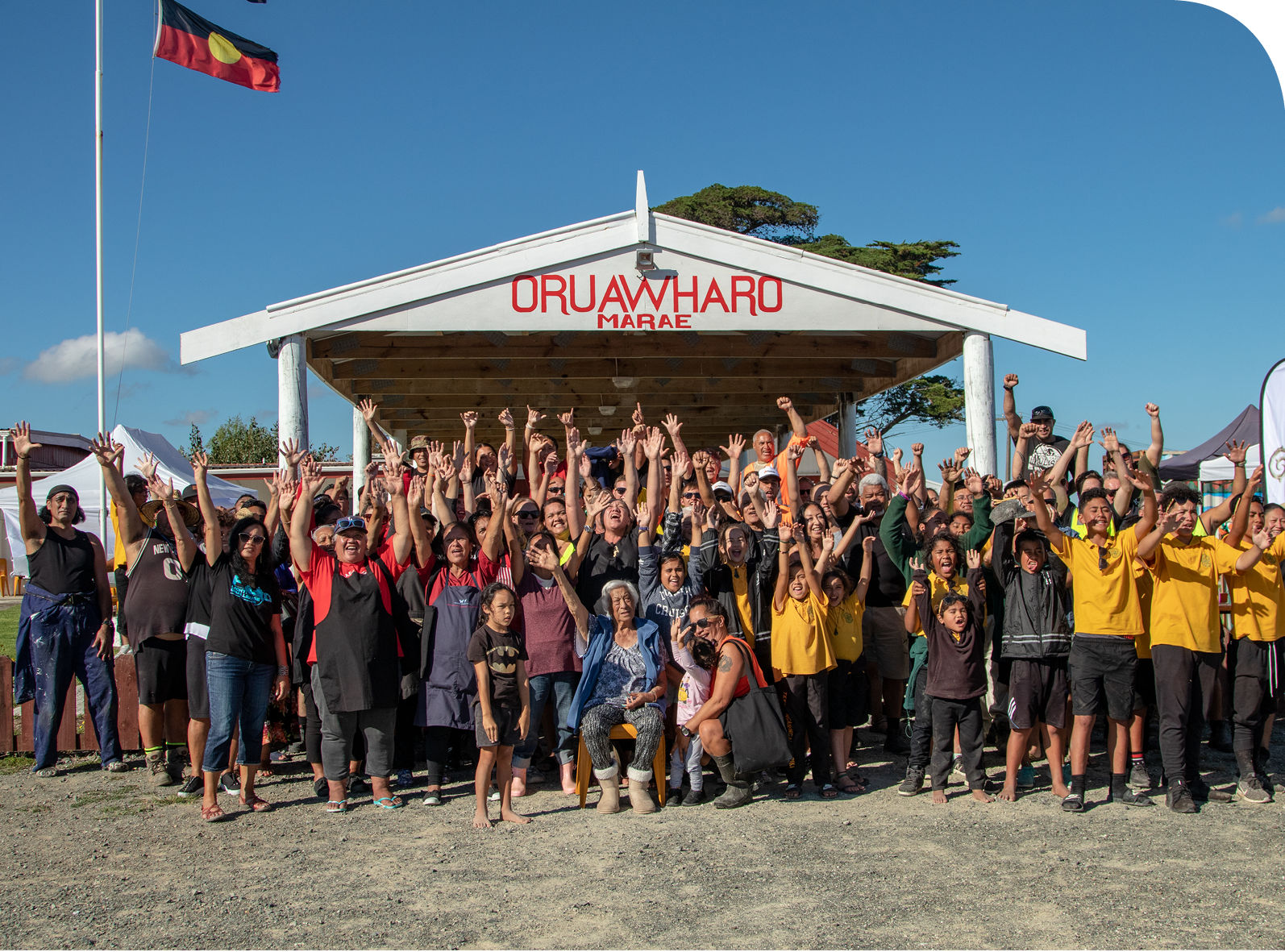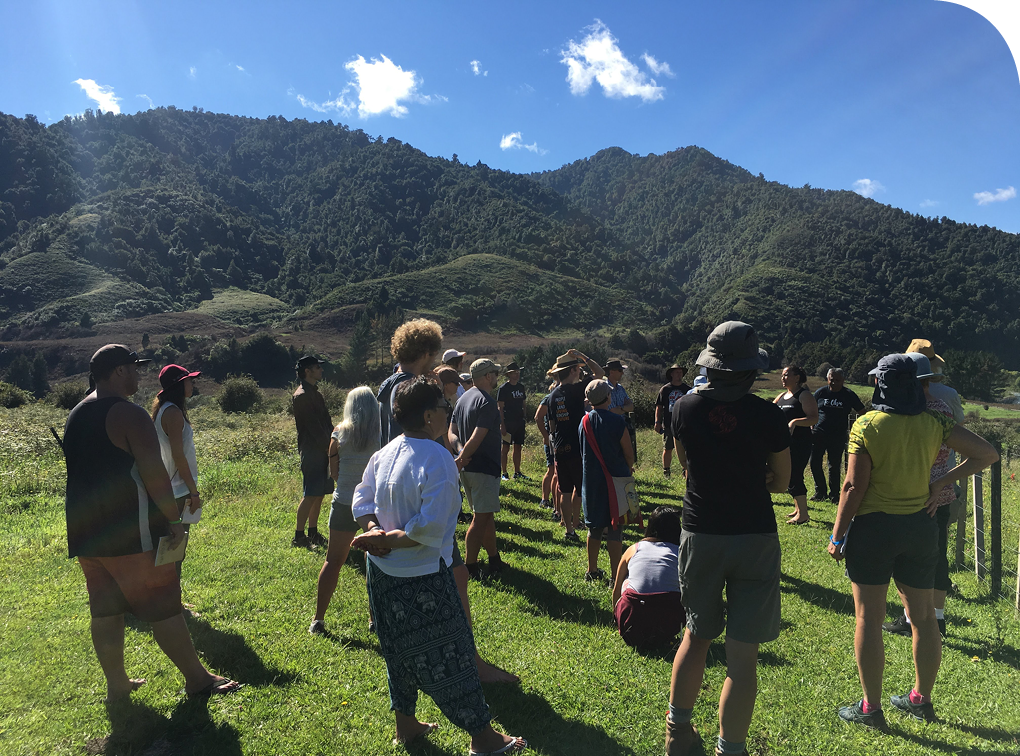marae diy.
CLIENT | Screentime Productions
OUR ROLE | Sustainability Advisor
Marae DIY has been on Aotearoa TV screens for 15 years. During that time, kuia and kaumatua have told the camera they wish we could go back to the old ways of doing things; reconnecting with nature and taking better care of the whenua, wai and each other.
Screentime Productions engaged Done as Sustainability Advisor to support marae whanau as they take steps towards this. To film this season, we had the pleasure of working with seven marae in various locations throughout Aotearoa and supported mahi which allows the marae to be more self-sustaining, leave less impact, and regenerate their surroundings.
te kura whare: tuhoe living building.
CLIENT | Ngāi Tūhoe
OUR ROLE | Living Building Challenge Delivery
We are delighted to have supported Tūhoe through the Living Building Challenge (LBC) certification process which led to Te Kura Whare becoming the first fully certified Living Building in the world outside of the USA.
The LBC is the world’s most stringent proven performance standard for buildings. The LBC comprises seven performance areas: site, water, energy, health, materials, equity and beauty. It requires significant effort from the client and project team to design, build and occupy a building which is net zero energy, water and carbon and which excludes toxic materials.
In 2011 Ngāi Tūhoe took on this challenge when they decided to create a building - Te Kura Whare - which would not only meet the rigorous requirements of the standard, but would also demonstrate their unwavering commitment to responsible development which respects the environment we co-exist with.
Samantha engaged with the Living Building Challenge through design, construction, occupancy and auditing and gained valuable insights from participating in this process for the first time in New Zealand. Samantha was responsible for compliance with the Living Building Challenge on site. Samantha coordinated community engagement including, most notably, more than 200 volunteers in the creation of 5,000 hand-made earth bricks, Finally, Done worked alongside a team from Tūhoe Te Uru Taumatua to review, collate and present the evidence required to prove compliance with the standard.
tapu te ranga marae.
CLIENT | Tapu Te Ranga Marae Whanau + Screentime Productions
OUR ROLE | Sustainability Advisor + Build Team
Tapu Te Ranga Marae, in Wellington’s Island bay was built in the 1970’s by the late Bruce Stewart when he was released from jail with ‘$25 and a dream’. Tapu Te Ranga was an incredibly unique, ten-story, urban whanau Marae made predominantly of reclaimed timber and metal from dismantled car bodies. Bruce passed away in 2017, leaving his legacy to twelve children. In the summer of 2019, this whanau decided to take on a Marae DIY as a way to come together and move forward after their father’s death. All the work undertaken as part of the DIY had to follow Bruce’s philosophy of making the most of what’s around you and being inventive with existing materials to avoid waste and the need to by new.
The whanau were keen to learn earth-building processes so that they could use the earth available within their 300-acre site as a material for future development. We taught Marae whanau how to build using a rammed-earth technique and tested how their own soils and clay worked during construction. Following four decades of hanging on to materials in case they were needed – the Marae underwent a major clean-out and a significant recycling area was created to better organise future potential-waste streams generated by Marae hosting and events. Using all reclaimed timber, the two marae entrances were given an overhaul to provide a sense of arrival and manaaki to visitors – as the Marae is open to, and often used by, anyone who needs it. From the entrance, prominent timber pou were installed to guide the path to an atea, where a tomokanga and landscaping were introduced to define what was and otherwise empty lawn area. The toilets and showers were fully renovated, again to enhance manaaki to visitors.
Unfortunately, this incredible structure was destroyed by fire in June 2019, just a few months after the DIY took place - though we know the Stewart whanau will find a unique way to make the most of what they have and move forward once again.
te kura whenua: waikaremoana visitor centre.
CLIENT | Ngāi Tūhoe
OUR ROLE | Project Manager
Te Kura Whenua, the Waikaremoana Visitors Centre nestles against the shores of Lake Waikaremoana in the heart of the remote Te Urewera rainforest.
The building is a focal point for the Waikaremoana community and visitors alike; housing space for local business, a cafe and information for visitors who travel to the area for the Great Lake Walk and other activities.
The remote build brought with it many challenges including a three-hour drive on a winding gravel road to access the site. There was no cell phone reception and the area is prone to heavy rainfall. These conditions called for a creative approach to delivery, very careful programming, risk management and prefabrication. In alignment with Tuhoe’s Living Building, Te Kura Whare, a steady eye was kept on materials to avoid red-list chemicals throughout the build.
oruawharo marae.
CLIENT | Oruawharo Marae Whanau + Screentime Productions
OUR ROLE | Sustainability Advisor + Build Team
The whanau at Oruawharo Marae gave their large Marae a huge overhaul. They re-painted their buildings, built an extension to their kauta (kitchen) and tidied the landscaping throughout their large site.
Because of their remote location, people arriving at Oruawharo would often have travelled some distance from the last ‘comfort’ stop. To offer strong manaaki (hospitality) to their visitors, the whanau chose to install a manuhiri (visitor) toilet in front of the Marae, which manuhiri could use before being allowed onto the Marae through a formal powhiri (welcoming) process. The Whanau chose to install a Biolytix Biopod which works by mimicking the way nature breaks down waste and is far more efficient and less energy intensive than conventional wastewater treatment. This approach removes the need for significant pipework to and from the existing supply and waste systems, reduces water use, and produces purified and filtered water which was then pumped into the garden for further filtration as a beneficial irrigation resource.
For generations, people had been throwing their rubbish over the bank behind the Marae, creating an eyesore of a tip site. The site was indicative of an old way of doing things which Whanau were keen to move away from. The area was cleaned up, waste was sorted into recycling streams and the bank was shaped and planted with natives. A seated area was created to overlook the harbour – providing a place to reflect on our role as kaitiaki (guardian) of the environment.
puhinui catchment regeneration.
CLIENT | Panuku Development Auckland
OUR ROLE | Regenerative Practitioner and Planning
Along with Resilio Studio and a diverse project team we are helping co-create a regeneration strategy and work programme that Panuku can implement for the restoration of Puhinui catchment. The ultimate goal is to improve the health of the water, the land and the people of Manukau.
The project reflects the place-based potential of the Puhinui in a way that strengthens existing relationships and establishes new ones between the many stakeholders who live, work, play, learn and explore within the Puhinui.
taheke marae.
CLIENT | Taheke Marae Whanau + Screentime Productions
OUR ROLE | Sustainable Advisor + Build Team
The community at Taheke Marae, in the Hokianga, were strong and committed to the restoration of their Marae. Whanau were clear that their priority was to restore their Wharenui to greatness and direct their focus and attention to her. During construction, over 300 whanau members volunteered on site daily, including several highly skilled tradespeople. As a result, in just four days, we were able to complete a full renovation of the wharenui including re-cladding, re-roofing, solar panel install, replacing rotten framing, new windows and doors, insulation and a complete internal refurbishment including new lining, restored carvings, and new carpet.
As the wharenui is considered a living being, the whanau wanted to approach the renovation with a high level of care, and we made sure that only the healthiest materials were used to re-build her. All internal building materials were low VOC and had Declare labels (the health label for building materials), providing a healthy, comfortable environment for those who would occupy the Wharenui.
It was moving to be part of this Marae DIY and work alongside the Taheke whanau, who proved incredible, high-quality outcomes can be achieved at pace when community is strong and connected.
auckland regional pest management strategy.
Client | Auckland Council
Our role | Project Management
Pest Management - it’s about protecting beautiful creatures like these. The continued abundance of New Zealand’s native biodiversity depends on it. Done. project managed the development of Auckland Council’s Regional Pest Management Plan; a statutory document prepared under the Biosecurity Act for controlling pest plants, animals and pathogens in the region. The project drew on a range of Kristen’s skills, including project management, policy development and community engagement.
Auckland Council approved the plan in early 2020, and a small handful of appeals were dealt with through mediation. At its completion, the project was noted by Auckland Council’s General Manager Environmental Services as “an exemplar of best practice from the outset... characterised by technical excellence and rigour, clear quality advice to elected members and a thorough inclusive public consultation process.”
te tii village.
Client | Ngāi Tūhoe
Our role | Sustainable Development Management
Te Tii was created as a vibrant, central hub for Ruatāhuna, a remote village located at the gateway to Te Urewera. Te Tii stands to breathe new life into the village, to uplift and connect the local community. It anticipates the arrival of visitors that want to experience the Tūhoe way of life, to spend time in Ruatāhuna and be introduced to Te Urewera. The facility boasts an office building, general store, café, gas station, motel, radio station, laundry, market place, community garden and other inviting outdoor spaces.
Within our Sustainable Development Management role we looked towards the project as a vehicle to connect and enrich the human community and the environment. Every opportunity for community contribution, up-skilling, capacity building and leadership advancement was pursued.
A highlight was connecting over 20 dedicated local workers with contractors and seeing their skills and confidence develop. Seven people were promoted as a reflection of their enhanced skills and two others undertook carpentry apprenticeships. Local marae hosted contractors traveling from out of town, and children and pakeke (elders) were involved throughout. Tūhoe continue to lead in their approach to sustainability. Toxic building materials were excluded from the complex, energy is generated by solar panels and adjacent streams have been enhanced to improve the environment for fish. The on-site waste-water treatment system not only treats waste from the new facility, it ties in six neighboring homes and replaces individual septic tank reliance with a communal solution. This truly was a community project – and a pleasure to be a part of.
healthy waters waiora partnerships process improvement.
Client | Auckland Council
Our role | Project Management
Water. It’s our most valuable resource. As the human population grows, so does our water use. Currently we’re using water much faster than our supply can support. By 2030 it is estimated that half the world will be living in high water-stress areas. That’s why we need to take the best possible care of the water we do have access to right now.
Waiora Partnerships is a team based within Auckland Council’s Healthy Waters division. Their role is to empower Auckland communities with projects and programmes to improve water quality, protect water from further damage and encourage ownership of this collective issue.
They are currently working with 21 Auckland Local Boards to deliver around 300 community led projects per year. The team asked Done to complete an independent review of their way of working and design an improved process which maximises the potential for high quality outcomes.
ellerslie motorway noise barrier.
CLIENT | Ellerslie Healthy Environment Society
OUR ROLE | Provision of advice regarding resource management legislation and policy in NZ
Done supported the Ellerslie Healthy Environment Society in their bid for a motorway barrier along the Ellerslie stretch of the Southern Motorway to address long-standing noise and safety concerns.
Local residents had noticed an increase in road noise over time, particularly following the widening of the north bound lanes at the Ellerslie Panmure interchange.
Done contributed to the project by reviewing technical planning documents and providing advice about strategies to address noise issues.
The wall is up, the noise is down! We’re thrilled to have been part of a team that contributed to such a positive outcome for the health and happiness of the Ellerslie community.
cunningham building renovation.
CLIENT | New Zealand Institute of Plant and Food Research
OUR ROLE | Project Manager
With construction and demolition waste making up over half of New Zealand’s waste sent to landfill – restoring and renovating our existing building stock is one of the easiest ways to limit our environmental impact.
The Ministry of Plant and Food Research (PFR) decided to re-purpose the The Cunningham Building that was built in 1938. Rather than it just being used as office space for individuals they wanted it to house a wider range of campus needs. Samantha had the privilege of project managing design and construction to achieve this change.
Stripping the rabbit warren of small offices to reveal the building’s art deco shell was highly complex. Both internal and external demolition followed the strict procedure required to remove asbestos contaminated material while PFR maintained business as usual. The building was seismically strengthened by running reinforcing steel vertically, from the basement, through each floor slab, to connect with the roof. Then the face of all internal walls were sprayed with concrete.
The result is now proving itself as it has become the heart of PFR’s Mt Albert campus.
hamilton building renovation.
CLIENT | New Zealand Institute of Plant and Food Research
OUR ROLE | Project Manager
The 5,000m2 seven-storey Hamilton Building is also situated at PFR’s Mt Albert Campus. The complete internal and external reburbishment of the 1973 building allowed it to be brought up to advanced modern standards.
The project included asbestos removal, roof and facade replacement. Four floors were converted into state-of-the-art PC2 labs and three floors into open plan office and meeting room spaces.
Samantha provided contractor pre-construction services during the design phase. This included buildability and programming advice, the co-ordination of key subcontractors and the interaction with consultants to provide the best outcome to the client.
18 months of design and planning resulted in a well-considered construction plan which made it possible for Plant and Food Research to remain operational during construction.
te ohu: people, land kinship.
CLIENT | The Living Future Collaborative New Zealand and Tūhoe - Te Uru Taumatua
OUR ROLE | Co-design
We had the pleasure of co-designing an event with Tūhoe - Te Uru Taumatua and the Living Future Collaborative New Zealand; Te Ohu 2018: People, Land, Kinship – Our Living Future which was held in Tāneatua, Bay of Plenty in February 2018. 120 people gathered from around the world for the four day live-in event. The focus of Te Ohu was to explore philosophes, principles, purpose and concepts to guide the design and development of future Tūhoe village communities, within the broader ecosystem.
It was a unique exchange between manuhiri (visiting participants) and Tūhoe. Tūhoe shared their innate expertise and philosophies for living in unity with the natural world and each other and demonstrated their exceptional hospitality by hosting manuhiri across four marae throughout the event. Manuhiri brought an eclectic mix of expertise and experience in the development of living buildings, co-housing, food production, regenerative development, beekeeping, education, governance and landscape architecture to name only a few. Trustworthy participants willingly hopped on buses to locations throughout the Tūhoe region without knowing where they were heading, and engaged in nature experiences and workshops.
It was a whirlwind adventure which deeply impacted those who participated. The feedback we've heard which best summed up the four days:
"I saw hope in engineers who were willing to listen, spiritualists who were willing to think, elderly who were willing to change and children who were willing to embrace tradition."
environmental services unit strategic sustainability.
Client | Auckland Council
Our role | Specialist Sustainability Advice and Programme Review
We were commissioned by Auckland Council to provide strategic advice, project management and facilitation support to the Environmental Services Unit.
This involved several projects including:
+ reviewing the Eco Design Advisory Service to ensure future delivery reaches a wide audience and meets intended strategic objectives
+ advising on the team's low carbon living strategy
+ leading a team of analysts assessing feedback on the Natural Environment Targeted rate through the Long Term Plan and
+ project management of subsequent local board engagement regarding implementation of enhanced environmental programmes supported by the rate.















